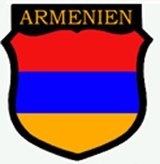Allegiance Nazi Germany Size 11,600 – 33,000 | Branch Wehrmacht Ceremonial chief Drastamat Kanayan | |
 | ||
Active 4 July 1942 – 8 June 1944 Engagements World War II
Eastern Front | ||
The Armenian Legion, also known as the 812th Armenian Battalion (German: Armenische Legion; Armenian: Հայկական լեգիոն Haykakan legion) was a military unit in the German Army during World War II. Consisting mainly of Soviet Armenian prisoners of war, the Armenians opted to fight for German forces rather than be sent to the Nazi POW camps or killed. The legion was led by former Defence Minister of Armenia General Drastamat Kanayan, who fought against the Soviet Union on the Eastern Front. Kanayan was among the minority in the legion who volunteered, under the hope of freeing Armenia from Soviet control.
Contents
The total number of Armenians serving in the German armed forces during the war reached 33,000. Of these, 14,000 were placed in field battalions, while another 7,000 served in logistical and other non-combat units. The legion participated in the occupation of the Crimean Peninsula and the Caucasus. Several Jewish soldiers captured as POWs were saved by some of the Armenians in the Legion and there were several instances of Jews being sent to the battalion to evade detection by the Nazis. Towards the end of the war, many of the legion deserted, defected or revolted.
In spite of Nazi Germany acknowledging the Armenians as an Aryan people, Adolf Hitler personally did not trust them. The Armenian battalion was mainly stationed in the Netherlands as a result of Hitler's distrust.
Background
The short-lived First Republic of Armenia established in 1918 by the Armenian Revolutionary Federation (ARF, Dashnaks) was conquered by the Russian Bolsheviks in 1920, and ceased to exist. During World War II, some of the Dashnaks tried to counter Turkish propaganda which falsely portrayed Armenians as a Semitic people close to the Jews to ensure their genocidal destruction should Soviet Armenia fall under Nazi rule. To fight Turkey's anti-Armenian politicking, the Dashnaks entered into negotiations with Berlin, and reluctantly agreed to participate in the formation of the legion. The majority of the soldiers in the legion were former Soviet Red Army prisoners of war, who had opted to fight for German forces rather than face the genocidal conditions of the Nazi POW camps. Some Berlin-based representatives of the Armenian Revolutionary Federation, though repudiated by the official party organs, made an agreement with the Nazis in 1942 to support the Germans against the Soviet Union.
On December 30, 1941 they formed a battalion of 8,000-strong known as the "812th Armenian Battalion of Wehrmacht" under the command of Drastamat Kanayan (Dro). A number of Armenian veterans who had escaped to the US after World War I came back to Europe to head it. General Drastamat "Dro" Kanayan, former Defense Minister of the First Republic of Armenia, led the legion, and fought on the Eastern front. French genocide scholar Yves Ternon, who has studied the battalion, suggested that while there were no "substantial" fascistic inclinations among the Armenians in general, Kanayan was an exception; Ternon characterized "Dro" as possessive of substantial "fascist deviation."
Size
According to Joris Versteeg, the total number of Armenians serving in the German armed forces during the war reached 33,000: 14,000 were placed in field battalions, while another 7,000 served in logistical and other non-combat units. Ailsby puts the number at 11,600.
Armenian infantry battalions
808th Battalion
809th Battalion "Zeytun"
810th Battalion
812th Engineering Battalion
813th Battalion
814th Battalion
815th Battalion
816th Battalion
I / 125 Battalion
I / 198 Battalion
II / 9 Battalion
Activities
The legion participated in the occupation of the Crimean Peninsula and the Caucasus.
Several Jewish soldiers serving in the Red Army and captured as POWs were saved by some of the Armenians in the Legion. Josef Moisevich Kogan, a Jewish Red Army soldier captured by German forces, noted the help he received by an Armenian doctor in the 812th Battalion when he was sneaked into the battalion itself and later escaped with the help of Dutch underground resistance members. Other instances included Jews being sent to the battalion to evade detection by the Nazis. Hans Houterman reported that in one case a battalion in the Netherlands where the legion was stationed even revolted.
One part of the Armenian Legion formed the 4th Battalion of the 918th Grenadier Regiment, 242 Infanterie-Division, one of the few Eastern Legion units to be given German insignia after March 18, 1944. The battalion participated in the unsuccessful defense of Toulon. At the end of the war, the remaining members in the battalion surrendered to the Western Allied forces. If not detained by them, they were turned over to Soviet authorities who, under an order enacted by Soviet leader Joseph Stalin, were sent to camps in Siberia as punishment for surrendering to Axis forces and "allowing themselves to be captured," a fate suffered by nearly all of the former Soviet prisoners of the war.
Nazi perspective
Alfred Rosenberg, Hitler's Minister of the Occupied Territories, declared that the Armenians were Indo-European, or Aryans, and thus they were immediately subject to conscription. According to Versteeg, however, "Although Armenians officially were considered 'Aryans', the notion of them being 'Levantine traders', similar to the Jews, was deep-seated in Nazi circles, and racial 'purists' along with Hitler himself were prone to look upon the Armenians as 'non-Aryans.'"
Hitler himself expressed his doubts on the Armenian and other Soviet battalions. Speaking about military units from Soviet peoples, Hitler said: "I don't know about these Georgians. They do not belong to the Turkic peoples...I consider only the moslims [sic] to be reliable...All others I deem unreliable. For the time being I consider the formation of these battalions of purely Caucasian peoples very risky, while I don't see any danger in the establishment of purely Moslim units...In spite of all declarations from Rosenberg and the military, I don't trust the Armenians either."
